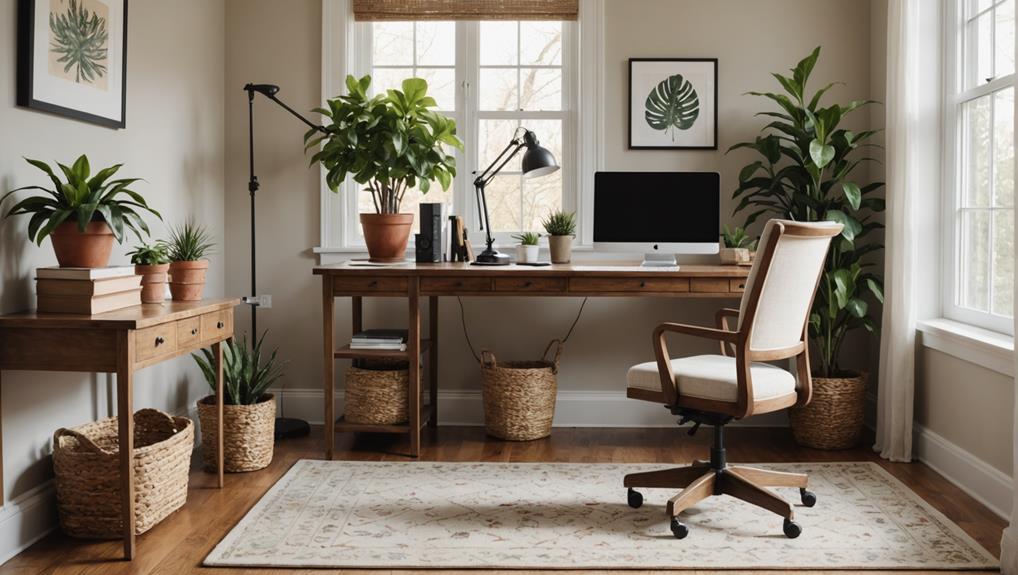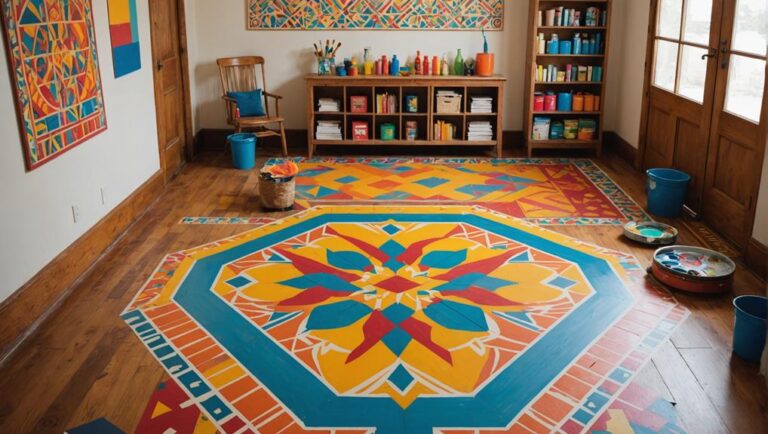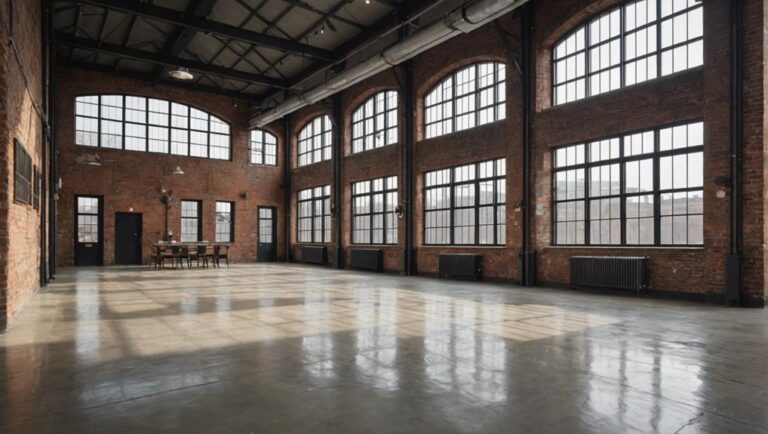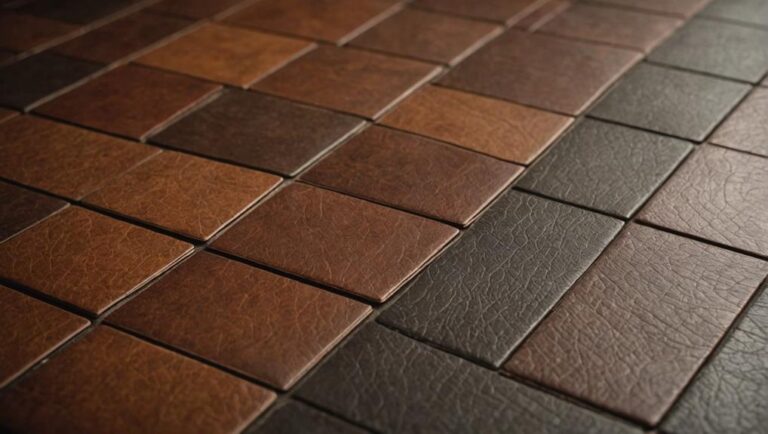Decorating your home office floors can really transform your workspace. Start by choosing durable materials like laminate or sustainable bamboo to enhance longevity and comfort. Think about color psychology; calming blues or energizing yellows can set the mood. Layering area rugs not only adds warmth but also helps define different work zones. Incorporate patterns carefully to create depth without overwhelming the space. Don't forget about acoustics; soft flooring materials can absorb sound for a quieter environment. With the right choices, you'll create a personalized, inspiring atmosphere that boosts productivity. There's more to explore, perfecting your design choices.
Choose the Right Flooring Material
How do you choose the right flooring material for your home office? It's crucial to evaluate several factors that affect both your comfort and safety. First, think about flooring durability. You'll want something that withstands wear and tear, especially if you're spending long hours at your desk. Materials like vinyl, laminate, or high-quality carpet offer excellent longevity.
Next, don't overlook acoustic properties. If you're in a shared space or if noise distractions bother you, opt for flooring that dampens sound, like carpet or cork. These materials also provide enhanced comfort levels, making your workspace more inviting.
Environmental impact is increasingly important. Look for sustainable options that minimize your carbon footprint. Bamboo and reclaimed wood are trendy choices that reflect your commitment to sustainability factors.
Installation ease is another factor; some materials require professional help, while others are DIY-friendly. Be mindful of cost considerations, too. High-quality flooring can be an investment but often pays off through durability and low maintenance requirements.
Safety should always be your priority. Choose flooring with good slip resistance, particularly if your office has a lot of foot traffic. Staying up to date with design trends can also enhance your office's aesthetic, creating a space that inspires productivity while reflecting your personal style.
Consider Color Psychology
While choosing the right flooring material is essential, the colors you select can greatly influence your productivity and mood in your home office. The emotional impact of color isn't just a design trend; it's a psychological principle that can help you create an environment conducive to focus and creativity.
When considering color selection for your flooring, think about the feelings and responses different hues evoke. For instance, blue is known for its calming effects, making it an excellent choice if you often feel overwhelmed. It can help you maintain a sense of tranquility while working on tasks that require concentration. On the other hand, vibrant colors like yellow can invigorate your space, fostering creativity and positivity, perfect for brainstorming sessions.
You might also want to opt for neutral shades like beige or grey, which can create a professional atmosphere while allowing you to add accents through decor or furniture. This approach keeps your office feeling open and airy, reducing distractions that could hinder your focus.
Don't forget about safety when selecting colors. Dark hues can absorb light, making a space feel smaller and potentially leading to eye strain. Lighter shades can reflect light, enhancing visibility and creating a more inviting workspace.
Ultimately, thoughtfully choosing your flooring colors can set the tone for your home office, helping you strike the right balance between productivity and comfort. So, consider the emotional impact of your color selection to create a workspace that inspires and supports your work.
Use Area Rugs Wisely
When it comes to incorporating area rugs in your home office, size really does matter; you want a rug that complements your space without overwhelming it. Think about how the colors of the rug can enhance your overall color scheme and create a cohesive look. Additionally, using rugs to define work zones can help establish boundaries, making your workspace feel more organized and purposeful.
Choose the Right Size
Selecting the right size area rug can transform your home office from a mere workspace into a cozy, inviting retreat. To achieve that desired atmosphere, you must consider the floor dimensions carefully. A rug that's too small can make the space feel disjointed, while one that's too large might overwhelm your office.
Aim for a rug that complements the furniture layout. Ideally, the front legs of your desk and chair should sit on the rug, creating a unified area that promotes space balance. If you have a seating area, make sure all the furniture pieces are anchored by the rug to enhance comfort and cohesion.
Measure your floor's dimensions first, then visualize how the rug will fit within the existing layout. Remember, a rug can also add an extra layer of safety by reducing slips and falls, especially on hard surfaces. Choose a material with a non-slip backing to further guarantee stability. By selecting the right size, you'll not only enhance the aesthetics of your home office but also create a safer and more functional environment that encourages productivity.
Complement Your Color Scheme
After you've settled on the right size for your area rug, the next step is to guarantee it harmonizes with your color scheme. Achieving color harmony is essential for maintaining a space that feels cohesive and inviting. A well-chosen rug can enhance your office's aesthetics while providing visual balance.
Here are some tips to reflect on:
- Match your palette: Choose a rug that incorporates colors from your walls, furniture, or accessories to tie everything together.
- Examine contrast: If your office is filled with neutral tones, a bold rug can serve as a focal point, adding depth and interest.
- Think about textures: A plush rug can soften hard surfaces, adding warmth and comfort, while a sleek design can maintain a modern feel.
- Test it out: Before committing, lay the rug down to see how it interacts with the surrounding colors and lighting.
Define Work Zones
Using area rugs strategically can transform your home office by clearly defining distinct work zones. When you section off your space with rugs, you create visual boundaries that help delineate areas for specific tasks. For instance, a plush rug under your desk can establish an ergonomic layout, promoting comfort while you work. Meanwhile, a smaller rug in a reading nook encourages relaxation and inspiration, enhancing your overall workflow efficiency.
Choose rugs that are both stylish and safe. Opt for non-slip materials to prevent accidents, especially in high-traffic areas. If you use an office chair on wheels, consider low-pile rugs that provide smooth mobility without compromising your stability.
Incorporate contrasting colors or patterns to further distinguish each work zone. Not only does this add aesthetic appeal, but it also serves to mentally separate tasks, boosting your productivity.
Lastly, remember to maintain a balance between functionality and design. Your area rugs should complement your workspace while ensuring you feel safe and comfortable. By thoughtfully arranging your office with these guidelines, you'll create an environment that fosters creativity and efficiency.
Layering Textures for Comfort
When it comes to creating a cozy atmosphere in your home office, layering textures can make all the difference. Think about choosing complementary materials that not only enhance the aesthetic but also provide comfort underfoot. By incorporating area rugs and mixing patterns strategically, you'll transform your workspace into a warm and inviting retreat.
Choose Complementary Materials
Although selecting the right flooring material is essential, layering textures can elevate your home office into a cozy and inviting workspace. By choosing complementary materials, you not only enhance the aesthetic appeal but also create a safe and comfortable environment. Opting for natural materials, like bamboo or cork, is a wise choice that promotes sustainability and adds warmth to your space.
Here are some ideas for layering textures:
- Wooden flooring: Offers durability and a classic look.
- Natural fiber mats: Provide a soft touch while maintaining breathability.
- Cork tiles: Offer cushioning and are eco-friendly.
- Recycled rubber: Great for sound absorption and easy maintenance.
Combining these materials thoughtfully can help you achieve a harmonious balance, guaranteeing your workspace feels both functional and welcoming. Remember, safety is key; make certain that any materials you choose are free from harmful chemicals and allergens. By focusing on sustainable options and natural textures, you'll create a home office that not only looks great but also feels good to work in. Embrace the synergy of materials for a workspace that inspires productivity and comfort.
Incorporate Area Rugs
Incorporating area rugs can transform your home office into a cozy haven, making it a perfect spot for productivity. By carefully selecting rug materials, you can enhance both the aesthetic and comfort of your workspace. Soft, plush rugs in wool or cotton not only feel great underfoot but also absorb sound, creating a quieter environment essential for focus.
When it comes to rug placement, think about the layout of your office. Position a large area rug under your desk to define your workspace while providing a cushioned surface for your feet. If your office is spacious, layering smaller rugs can add depth and interest. Just make certain they're secured properly to prevent slipping, prioritizing your safety.
Choosing the right colors and patterns can also influence your mood and creativity. Opt for calming hues like blues or greens, or energizing colors like yellows or oranges, depending on your work needs. With the right rug materials and placement, your home office can become not just a functional space, but a comforting retreat where you can thrive.
Mix Patterns Strategically
Mixing patterns can be a game-changer in your home office, adding both visual interest and a touch of personality. When done right, it creates a sense of pattern balance and visual harmony that can transform your workspace into an inspiring environment. Here are some tips to help you layer textures effectively:
- Choose a Base Pattern: Start with a dominant pattern, like a large geometric design, that sets the tone.
- Mix in Smaller Patterns: Incorporate smaller, complementary patterns, such as stripes or florals, to add depth without overwhelming the space.
- Stick to a Color Palette: Use a cohesive color scheme to maintain visual harmony, ensuring that the patterns work well together.
- Vary Texture Levels: Combine different materials, like a plush rug with a sleek desk, to create a cozy yet professional atmosphere.
Incorporate Patterns and Designs
While you might think of flooring as a simple backdrop, incorporating patterns and designs into your home office can transform the space into a dynamic and inspiring environment. By choosing flooring with geometric shapes or bold graphics, you can create a visual interest that uplifts your mood and sparks creativity. Consider using area rugs with these elements to define your workspace while adding texture and warmth.
When selecting patterns, think about how they interact with your existing décor. If your office features minimalist furniture, a bold graphic floor design can serve as a striking focal point. Conversely, if your space is already busy with colors and textures, opt for more subtle geometric patterns that provide a sense of order. This balance is essential for maintaining a harmonious workspace.
Safety is paramount, especially in a home office. Ascertain that the materials you choose are slip-resistant, particularly if you opt for tile or vinyl with intricate designs. Look for options that have a durable finish, making them easy to clean and resistant to wear. This way, you won't just create a visually appealing space, but also a safe one.
Don't shy away from experimenting with color, either. A bright, patterned floor can invigorate your space and inspire productivity. Just remember, the key is to find a design that resonates with your personal style while enhancing the functionality of your home office. So go ahead, let those patterns pave the way to a more engaging work environment!
Think About Maintenance
When it comes to flooring in your home office, maintenance should be at the forefront of your decision-making process. You want a space that's not only stylish but also practical and safe for your daily tasks. Choosing the right flooring can greatly impact how much effort and money you'll spend on upkeep over time. Consider these key factors:
- Cleaning Frequency: Select materials that require minimal cleaning, allowing you to focus on work rather than constant upkeep.
- Spill Resistance: Look for floors that can withstand occasional spills and messes, ensuring you won't stress over accidents during your busy day.
- Durability Factors: Invest in flooring designed for high traffic areas to prolong its life and reduce wear and tear.
- Maintenance Costs: Assess the long-term costs associated with upkeep and repairs, as this can affect your budget greatly.
Additionally, think about flooring longevity and how well it will stand up to daily use. Some materials offer straightforward repair options, which can save you time and hassle down the line. Seasonal care, like protecting your floors during extreme weather conditions, is also essential. Finally, consider surface protection measures, such as rugs or mats, to extend the life of your flooring and enhance safety in your workspace. By prioritizing maintenance, you'll create a home office that not only looks great but also serves you well for years to come.
Optimize for Acoustics
Sound can be a significant factor in your home office environment, impacting concentration and productivity. To create a serene workspace, consider implementing soundproofing techniques that effectively minimize distractions. Start with sound-absorbing carpets; their dense fibers trap sound waves, reducing noise levels and providing a cozy feel underfoot. Pair these carpets with soft furnishings, like floor cushions and plush chairs, to further dampen sound and enhance comfort.
Acoustic panels are another excellent addition; strategically placing them on walls can drastically improve your office's acoustics. Choose colors and designs that complement your decor while ensuring they serve their purpose. Additionally, consider incorporating noise-reducing materials into your office design. Think about using curtains made from thick, heavy fabric or installing wall insulation that reduces sound travel between rooms.
Don't overlook the ceiling—ceiling treatments, like acoustic tiles, can absorb sound that would otherwise bounce around the room. This not only elevates your office's aesthetic but also contributes to a quieter atmosphere.
Create Defined Work Zones
Creating defined work zones in your home office can greatly enhance your productivity and focus. By segmenting your space into specific areas, you can establish an ergonomic layout that promotes a smooth productivity flow. Whether you're tackling projects, brainstorming ideas, or enjoying a moment of relaxation, having designated spaces can help you stay organized and mentally agile.
- Work Zone: This is your primary area for tasks requiring concentration. Use a sturdy desk and comfortable chair to support long hours.
- Creative Zone: A spot for brainstorming and ideation, perhaps with a whiteboard or comfortable seating to inspire creativity.
- Break Zone: Designate an area for short breaks, equipped with soft seating or a small table for refreshments to recharge your mind.
- Meeting Zone: If you often collaborate, consider a small table for video calls or face-to-face meetings, ensuring it's comfortable yet professional.
When designing these zones, think about how you move between them. A clear path not only enhances productivity flow but also reduces strain on your body. Use rugs or different flooring materials to visually separate each area, which can also help in defining boundaries without physical barriers.
Personalize With Decorative Elements
Personalizing your home office with decorative elements can transform the space into a reflection of your personality and work style. By adding personal touches and decorative accents, you create an environment that inspires you and enhances productivity. Start with the flooring; choose rugs or mats that not only add comfort but also complement your decor. Opt for non-slip options to guarantee safety while working.
Next, consider wall art that resonates with you. Whether it's motivational quotes, landscapes, or abstract pieces, these artworks can stimulate creativity and make your workspace feel more inviting. If you prefer a more subtle approach, framed photographs or personal mementos can serve as excellent decorative accents without overwhelming the space.
Plants are another fantastic way to personalize your office. They not only beautify the area but also improve air quality, creating a healthier workspace. Just make certain to select plants that are easy to care for and safe for your environment, especially if you have pets.
Don't forget about your desk accessories. Choose organizers, pen holders, and other tools that reflect your style. A cohesive color scheme can tie everything together, making your office feel harmonious and well thought-out.
Lastly, think about lighting. Decorative lamps or fairy lights can add warmth and personality while guaranteeing adequate illumination. By thoughtfully incorporating these elements, your home office will not only look great but will also feel like a true extension of you.
Frequently Asked Questions
What Are the Best Flooring Options for Small Home Offices?
When considering the best flooring options for your small home office, think about color schemes that create a calming atmosphere. Light colors can make the space feel larger, while darker shades add warmth. Don't forget texture variety; you might mix hardwood with plush rugs for comfort and style. Safety's key, so look for non-slip options and make certain the materials are durable. Your flooring choice can enhance both productivity and aesthetics in your workspace.
How Can I Make My Office Floor More Eco-Friendly?
If you want to make your office floor more eco-friendly, consider using sustainable materials like bamboo or cork, which are renewable and durable. Pair these with natural finishes that avoid harmful chemicals, ensuring a safer environment. You could also explore recycled materials or low-VOC options. Not only will this enhance your workspace's aesthetic, but it'll also contribute to a healthier planet, reflecting your commitment to sustainability while keeping your office stylish and inviting.
What Budget-Friendly Flooring Solutions Are Available for Home Offices?
When it comes to flooring, think of it as the canvas for your creativity. Budget-friendly solutions like vinyl planks and carpet tiles can transform your space without breaking the bank. Vinyl planks are durable and easy to clean, giving you peace of mind, while carpet tiles offer comfort and warmth underfoot. Both options are versatile and stylish, ensuring your home office remains a safe haven for productivity and inspiration. You won't regret it!
How Do I Choose Flooring That Reduces Fatigue During Long Work Hours?
When you're choosing flooring to reduce fatigue during long work hours, consider anti-fatigue mats and ergonomic flooring options. These materials help distribute your weight evenly, providing comfort and support. Look for mats that offer cushioning and a non-slip surface to enhance safety. Additionally, softer flooring like cork or carpet tiles can absorb impact, making your workspace more comfortable. Prioritizing these features will help you stay focused and energized throughout your day.
Are There Specific Flooring Materials That Help Improve Focus and Productivity?
When it comes to improving focus and productivity, you'll want to contemplate acoustic flooring and ergonomic surfaces. Acoustic flooring can reduce noise distractions, creating a calmer environment, while ergonomic surfaces promote comfort and support during long hours. Together, they help maintain your concentration levels and can even enhance your overall well-being. Choosing the right materials can transform your workspace into a haven for productivity, ensuring you stay focused and safe throughout your workday.




